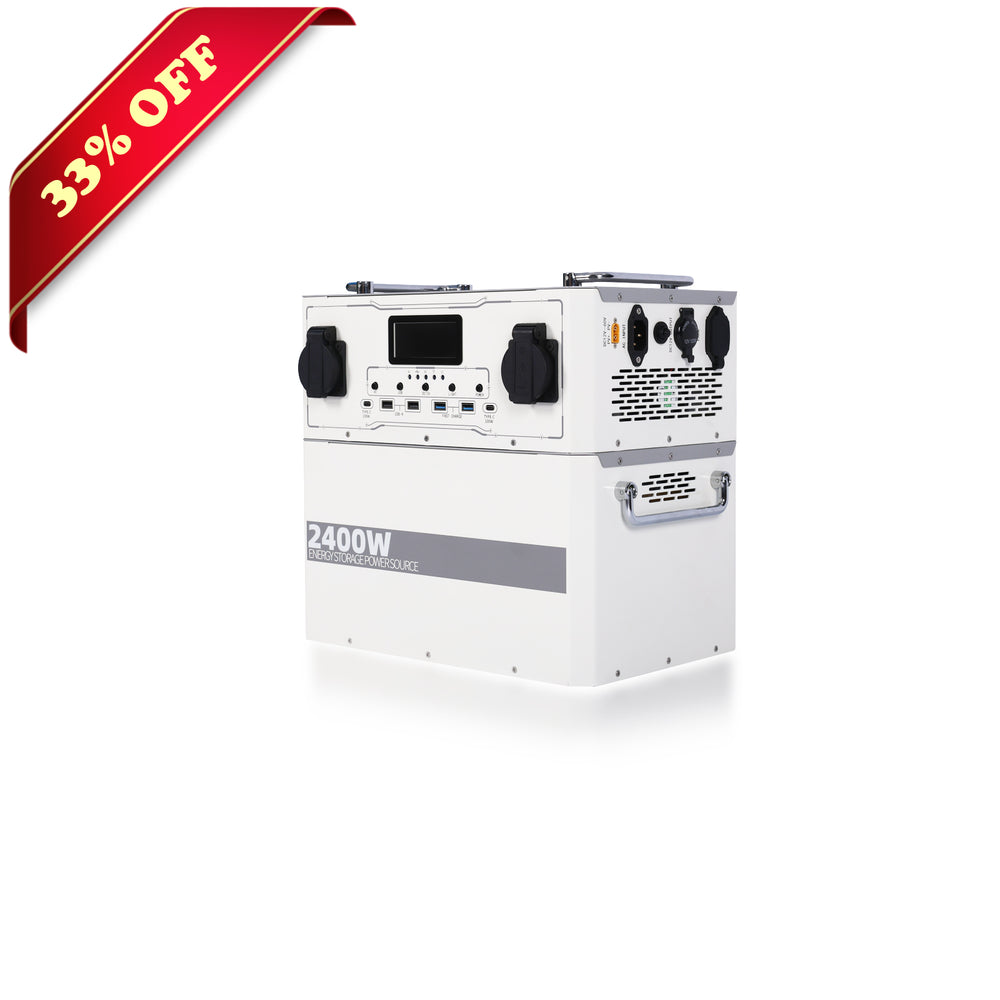Portable power stations have become the go-to solution for on-the-go energy needs, whether you're camping, tailgating, or just preparing for emergency power outages. They are convenient, eco-friendly, and can power a variety of devices. However, to get the most out of your portable power station, knowing how to properly charge it is crucial. Neglecting proper charging methods can shorten the lifespan of your device and reduce its efficiency.
A key benefit is that power stations can recharge, so you can use them repeatedly. But with different recharge speeds and inputs, how do you pick the best option for your model?
How Do Portable Power Stations Work?
The simple and compact design of portable power stations may have you believe that these devices are very straightforward, however, this couldn’t be farther from the truth. There are numerous intricate and sophisticated components working behind the curtains that allow portable power stations to function the way they do, i.e., provide you with portable and reliable energy for your gadgets and appliances.
Here are some of the primary components that make up a portable power station:
Battery
As mentioned before, portable power stations are essentially high-capacity battery packs. And so, like any normal battery, the portable power stations themselves must be charged before they can provide you with energy.
There are multiple ways to charge a power station, you can do it using solar panels, a generator, an AC outlet, or another battery. The difference, however, is the ports you’ll have to use. A generator and an AC outlet in your home would deliver AC power, therefore, when charging the station through these sources, make sure to plug them into the AC input port of the station.
On the other hand, a battery or solar panel will deliver DC power and so you must use a DC input port when charging the station using these sources. Portable power stations offered by Bluetti use a high-quality lithium-ion (LiFePO4) battery that provides you with long and reliable backup even after a thousand charge cycles.
Charge Controller
The batteries of a portable power station are also accompanied by an integrated charge controller. This device serves the purpose of regulating the current flow to and from the battery of the power station. Peirhw uses MPPT (maximum power point tracking) charge controller as well as BMS (Battery Management System) technology with its batteries. This helps protect the battery from overcharging, over-discharging, overheating, excessive voltage, and other detrimental hazards that can shorten a battery’s lifespan.
Inverter
Inverters are the vital component of a power station that allows it to work with both DC and AC energy types. Being a battery pack, a portable power station requires DC energy to charge its battery. But then how do you charge a power station using an AC outlet or a generator you wonder?
This is thanks to the inbuilt inverter in the power station that converts the AC energy input to DC before sending it to the battery for storage. However, this is not the only function that the inverter performs. Since power stations store only DC energy, they also deliver only DC energy. This raises a question: how can a power station then provide AC energy output for your appliances that only run on AC energy.
This is again thanks to the inverter that converts the outgoing DC energy to AC before it reaches the AC outlet ports. If you removed the inverter from the portable power station, this would essentially leave you with a bare battery that could only be charged through a DC power source and could power only DC appliances and electronics.
Considering that most of our electronic items and appliances operate on AC energy, a portable power station without an inverter wouldn’t be of much use to anyone. Peirhw portable power stations use only premium AC Pure Sine Wave Inverters capable of efficiently converting energy while minimizing conversion losses.
Fan
Some portable power stations, especially the high-capacity ones, also have an integrated fan that keeps the temperature of the power station in check. The smart temperature-activated fan automatically turns on when the temperature of the station begins to rise beyond a certain level. The absence of a fan can lead to overheating of the station internals which, in turn, could accelerate the degradation of the battery and other components.
5 Ways to Recharge a Portable Power Station
Recharge by AC Outlet
The simplest way to recharge a power station is to plug it into any 120V wall outlet using the included AC adapter. This works the same as charging a laptop or phone.
Connect the charging cable from the outlet to the power station's input port labeled AC, DC, or charging. AC outlet charging is relatively fast, usually 4-8 hours for a full recharge depending on the capacity. The downside is it ties you to the outlet until fully charged.
Use a Solar Panel
A major perk of power stations is recharging via solar panels. This harnesses free, renewable solar energy when off-grid without an electrical outlet.
Connect solar panels to the input labeled solar, DC, or charging. Position the panels in direct sunlight facing the sun to maximize power generation. Recharge times vary based on solar panel wattage and sunlight amount/intensity.
For instance, a 100W solar panel in full sun can typically charge a 500Wh station from 0% to 100% in about 5 hours. Using multiple panels reduces recharge time. When traveling, try placing panels on your car roof.
Recharge by Car Outlet
Many power stations can recharge by plugging into a 12V car, truck, RV, or boat outlet (cigarette lighter outlet). This lets you top up the charge as you drive or travel.
Use the station's charging cable with the vehicle's 12V outlet. Make sure the vehicle is on to prevent draining the battery. Car recharging is slower due to lower wattage, often 10-15 hours for a 500Wh station. Although slow, it's convenient for trickle charging over long trips.
Use a Generator
Portable gas generators provide engine-powered AC to recharge stations. This gives renewable energy to conveniently fuel up your station.Connect the station's charging cable to the generator's AC outlet. Verify it's rated for 120V to match household outlets and prevent damage.
Recharge times vary based on the generator's rated wattage. A 2000W generator can typically charge a 500Wh station from 0% to 100% in 2-3 hours, making generators one of the fastest recharging options.
For electronics, choose an inverter generator for clean, stable AC power. Follow the manufacturer's safety guidelines carefully when using a generator.
Recommend:
Tips for Optimizing the Charging Process
Use High-Quality Cables
Using high-quality cables is essential for optimizing the charging process of a portable power station. Cheap or low-quality cables can cause voltage drops and reduce the charging speed and efficiency. It is recommended to use the cables that come with the power station or purchase high-quality cables that are compatible with your power station.
Don't Overcharge the Power Station
Overcharging a portable power station can damage the battery and reduce its lifespan. Most power stations have a built-in protection system that prevents overcharging. However, it is still important to monitor the charging progress and disconnect the power station when it is fully charged. You should also avoid leaving the power station plugged in for extended periods when it is not in use.
Keep the Power Station in a Cool Place
Heat can reduce the efficiency and lifespan of a portable power station. It is recommended to keep the power station in a cool and dry place, away from direct sunlight and heat sources. You should also avoid charging the power station in extreme temperatures, as it can affect the battery performance.
Benefits of Using a Portable Power Station
Here are some reasons why you should consider buying a portable power station:
- Requires very little maintenance and is one of the most low-maintenance power sources available.
- Does not produce any noise.
- Pairing with portable solar panels will grant you a self-sustaining energy source that provides you free energy.
- Are safe to use since they do not produce harmful fumes or sparks as gas generators do.
- Can offer you clean, emission-free, and sustainable energy.
- They are cost-effective in the long run since you can produce free energy without any additional expenses and they require very little maintenance.
FAQs
How long does a portable power station hold a charge?
The answer depends largely on what type/size/capacity battery was installed in the device when purchased - larger capacity batteries tend to hold their charge longer than smaller ones but generally range anywhere from 6-24 hours. To maximize your device’s lifespan, it is best to unplug it when not in use and recharge it regularly.
Can you leave a portable power station plugged in all the time?
Not recommended - overcharging batteries has been known to reduce their capacity over time making them less effective so plugging them in only when necessary would be best.
How Long Will a Portable Power Station Last?
There is no one answer to this question since the backup time largely relies on the appliances and electronic devices you’re powering via the power station as well as the capacity of the power station. A high-capacity power station will easily last you several hours on moderate use.
What Can You Use a Portable Power Station For?
You can use a portable power station on your camping trip, to power your RV or off-grid cabin, or you could even use the system at your home during a power outage.












 Peirhw Inflatable House Tent - Starry Night Love
Peirhw Inflatable House Tent - Starry Night Love
 Peirhw Glamping Tents - Friendship Castle
Peirhw Glamping Tents - Friendship Castle
 Peirhw Inflatable Canopy Tent - Adventurer
Peirhw Inflatable Canopy Tent - Adventurer



 Peirhw Portable Air Conditioner
Peirhw Portable Air Conditioner
 【Advance Sale】Peirhw Portable Power Station 2400W
【Advance Sale】Peirhw Portable Power Station 2400W
 【Advance Sale】Peirhw Portable Power Station 600W
【Advance Sale】Peirhw Portable Power Station 600W




 Peirhw Self Inflating Sleeping Pad
Peirhw Self Inflating Sleeping Pad
 Peirhw Air Mattress (8" Queen Type)
Peirhw Air Mattress (8" Queen Type)
 Peirhw Camping Sleeping Bag
Peirhw Camping Sleeping Bag


 Peirhw Butterfly-shaped Canopy for Camping
Peirhw Butterfly-shaped Canopy for Camping
 Peirhw Camping Waterproof Canopy (Cannot be Purchased Separately)
Peirhw Camping Waterproof Canopy (Cannot be Purchased Separately)


 Peirhw Outdoor Folding Chairs
Peirhw Outdoor Folding Chairs
 Peirhw Folding Camping Table
Peirhw Folding Camping Table












